In a way, this article concerns religious art, though the person who wrote it has no religious beliefs whatsoever. But when people really, passionately, even if unconsciously, believe – in a religion, a philosophy, an idea – that belief imbues the works they create with the power of human feeling. Art, music, architecture, literature, objects; that power that is retained whether or not the observer accepts or understands the ideas that are living within those things. That’s my opinion anyway; I may not believe in the supernatural, but I do believe the ‘natural’ contains magic of its own.
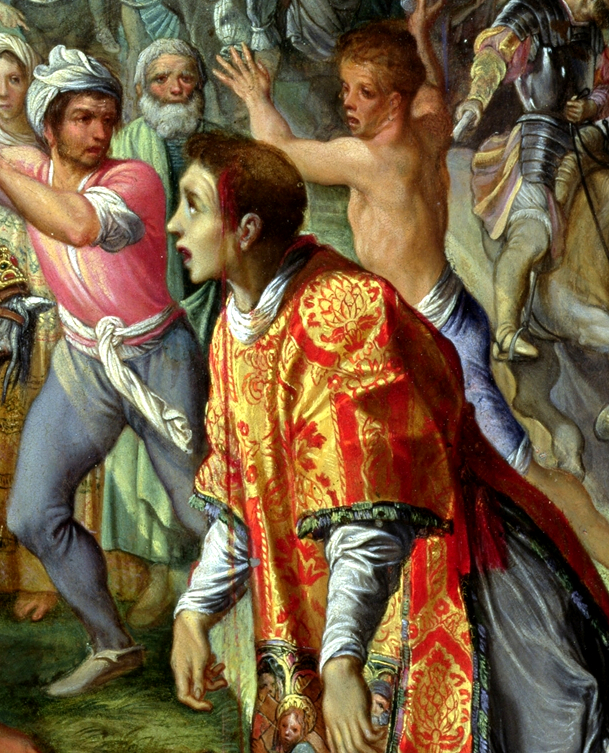
So anyway; when, in Purcell’s 1688 opera Dido and Aeneas, the dying Queen of Carthage sings Nahum Tate’s beautiful words, “Remember me, but forget my fate”, she is articulating something that was then becoming, and to some extent remains a kind of ideal as humanity tried, perhaps pointlessly, to distance itself from death. Caught in a pincer movement between the Reformation, which had eliminated much of the rich mythology of religion in its determination to reduce the clutter and distance between human beings and their God, and the dawning of what would become the age of reason, which sought to cast off the shadow of crude medieval brutality and superstition, death, once an unavoidable and largely accepted part of daily life, had become something akin to what it is today. That is, entirely acceptable – even celebrated, in fiction and entertainment, in real life it’s preferably kept out of sight and out of mind as far as is possible. But although the impulse to distance oneself from the more viscerally negative aspects of life is understandable, it’s almost the opposite of the way that people, for a couple of centuries at least, related to saints.
Saints have remained celebrated through the years to some extent, but still, since their medieval heyday they have found themselves playing a gradually diminishing role in Western European society. Interestingly though, while Christianity lost much of its cast of characters and stories through the ages, what it never lost in the Reformation – quite the opposite in fact – is that key idea which saints’ lives so often embodied: misery now, rewards later. And it was this, despite the apparent opposition of the two ideologies, which made Christianity and all of the Abrahamic religions such successful facilitators, or carriers (in the pharmaceutical sense) of capitalism. But, while saints faded from the vital figures of the middle ages into their current, more modest position, they remained venerated, if not worshipped, even in the Protestant faith, and still played a vital role in Catholic countries. That being so, plenty of the somewhat harrowing and graphic art generated in their names in earlier years survives; and rightly so.
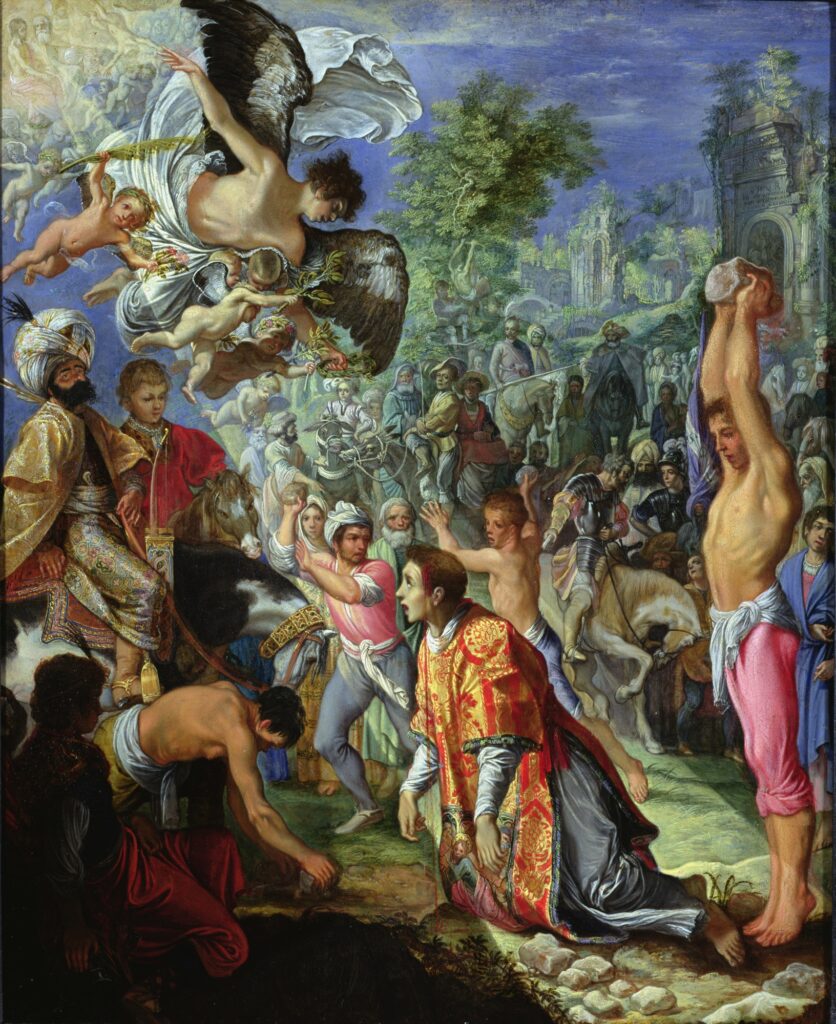
Take for example Adam Elseheimer’s 1603 Stoning of St Stephen. As a German artist working in Catholic Rome, Elseheimer’s position may have been anomalous, but no faith of any kind is required to understand and empathise with the young saint’s fate. We may not (or we may) share his implied, rather than shown, exultation at the parting of the clouds and the glimpse of heaven beyond, but we can recognise his pain, fear and loneliness. We’ve seen it many times, not only in cinema and in literature, but even more in news reports and photographs or, if we are unlucky, as eyewitnesses to (or victims of) real events. This painting make me think of the harrowing footage, a few years back, of prisoners being beheaded by Islamic State fighters, but they have echoes too, in those everyday acts of violence in which there are, thankfully, usually no deaths – but rarely any obvious sign of divine intervention either.
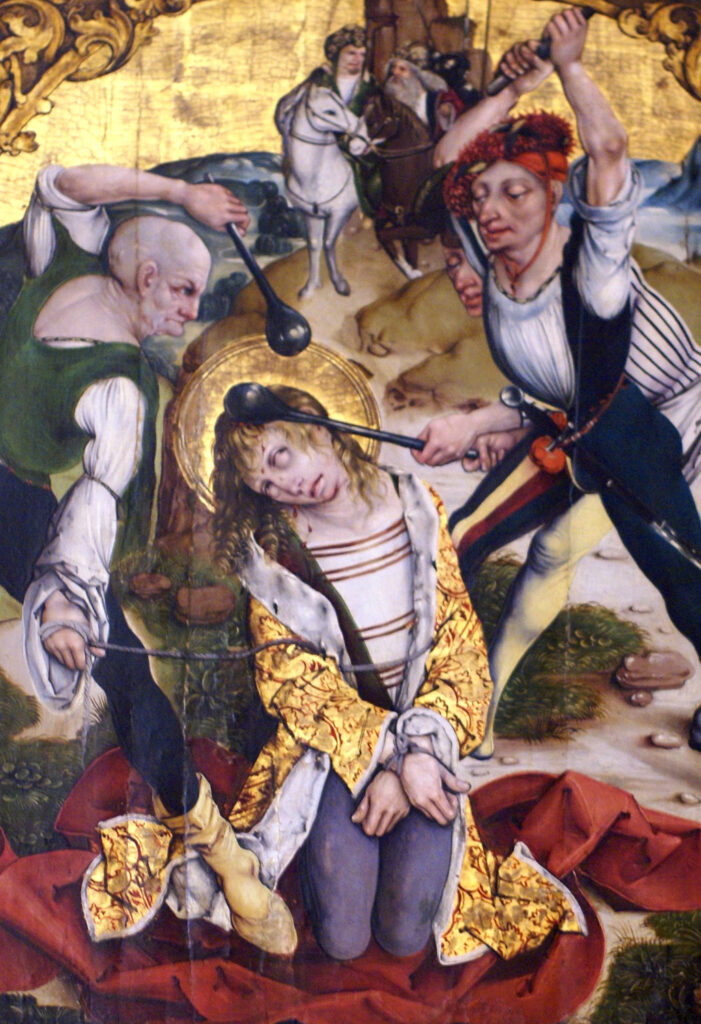
One of the most strikingly contemporary-feeling examples of the art of martyrdom is the series of Scenes from the life of St Sebastian in the Cathedral Museum, Mainz, painted by Master WB (probably the Middle Rhenish painter and engraver Wolfgang Beurer). St Sebastian is one of the most often-painted of saints, usually shown as a kind of surrogate Jesus, young and beautiful, but pierced by (sometimes a lot of) arrows. But the whole point of that part of his legend, is that the arrows didn’t kill him. Tended by St Irene of Rome (in the baroque era the healing of St Sebastian was painted quite often; there are some very beautiful and moving pictures, like the famous Georges de la Tour painting from 1650, and my favourite, by Hendrick Ter Brugghen, from a little earlier) he recovered, and went about his saintly business.
Unusually though, Beurer’s cycle of paintings takes the story past the Christ-like recovery of Sebastian and through to his eventual death, after he journeyed to see the Emperor Diocletian and scold him about his sinful life. This time, the young saint was clubbed to death and didn’t recover. This is a very different death from the ceremonial, iconic execution by arrows. There’s a sense of solemnity, of procedural, if dubious, legality that affords the victim of a firing squad a kind of Christ-like dignity – in paintings at least. There’s no way to make a clubbing to death look dignified though, and Beurer/Master WB doesn’t try. Instead he shows the by now pitifully uncomposed figure of the saint being beset by three cheerfully brutish soldiers with beautifully painted lead clubs.
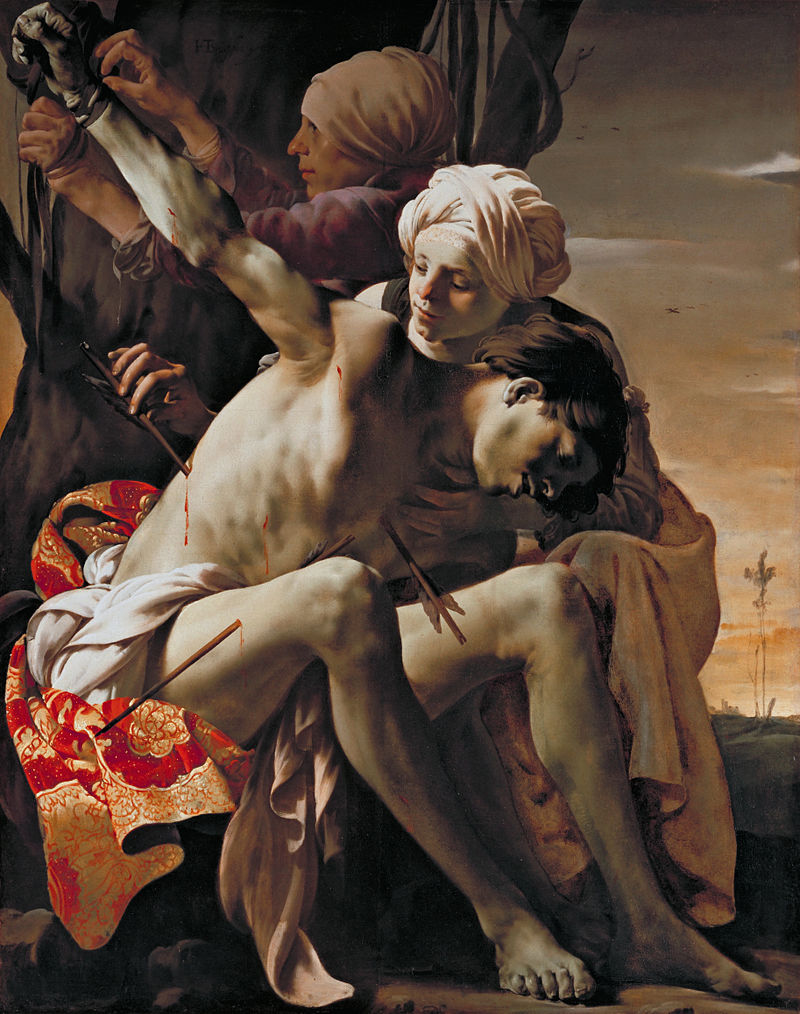
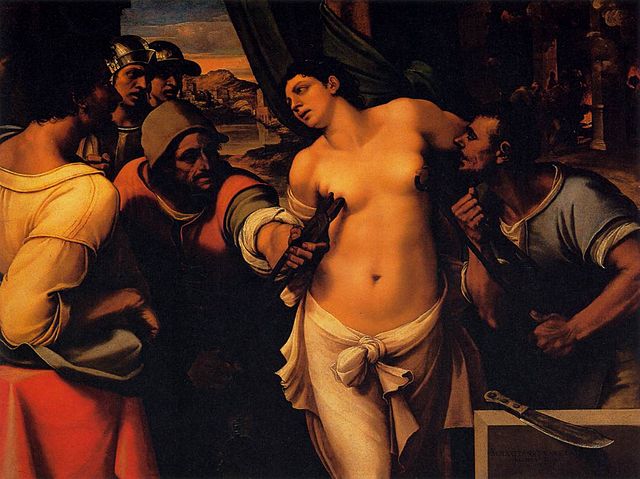
St Agatha, like Sebastian, is unusual in that her actual martyrdom – technically, she died in prison at some unspecified time later, after being healed by St Peter – is never pictured. Instead what is shown, essentially for titillating reasons, as horrendous as that is, is not even her torture, where her body was torn with hooks, but only the specific detail of her breasts being cut or torn off.
But although her death seems rarely to have been depicted, there are paintings of the healing of St Agatha in prison by St Peter. Partly this might be because of the two-saints-for-the-price-of-one nature of the image, but perhaps more importantly it afforded the artist another opportunity to show female nudity without fearing religious censure.
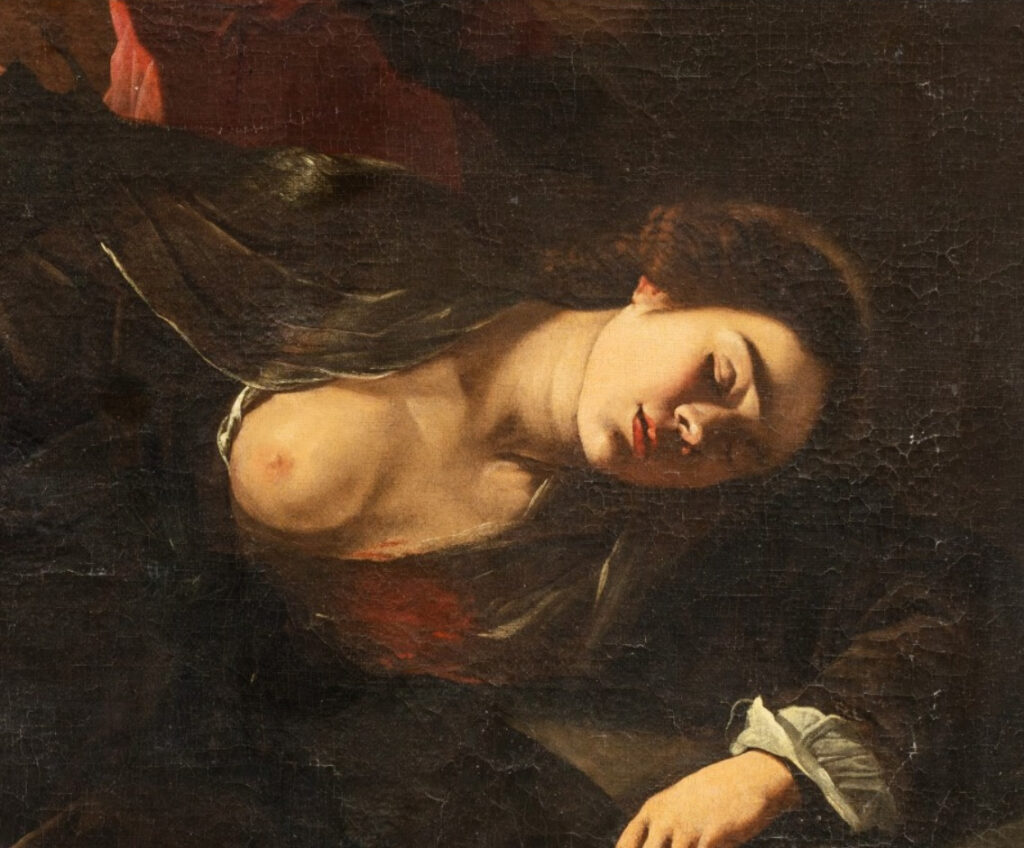
Although these paintings – Heinrich Vogtherr’s Martyrdom of St Erasmus (1516) is another great example – are full of religious feeling, it’s far easier as a secular person (or as this secular person) to respond emotionally to a painting of a martyrdom than it is to the ultimate martyrdom of the crucifixion of Christ. Jesus is of course something more than a human being, and though we are supposed to respond to his suffering in a human way, he’s still god after all; he presumably planned it and he can take it. Saints though, are different. The point may be the same – suffering holy people, relating to Christ as their father, in the same way that Christ related to god/himself as his – but these are just human beings. They may be idealised by artists, as they were in their official hagiographies, but they are supposed to be relatable for ordinary, unsaintly people.
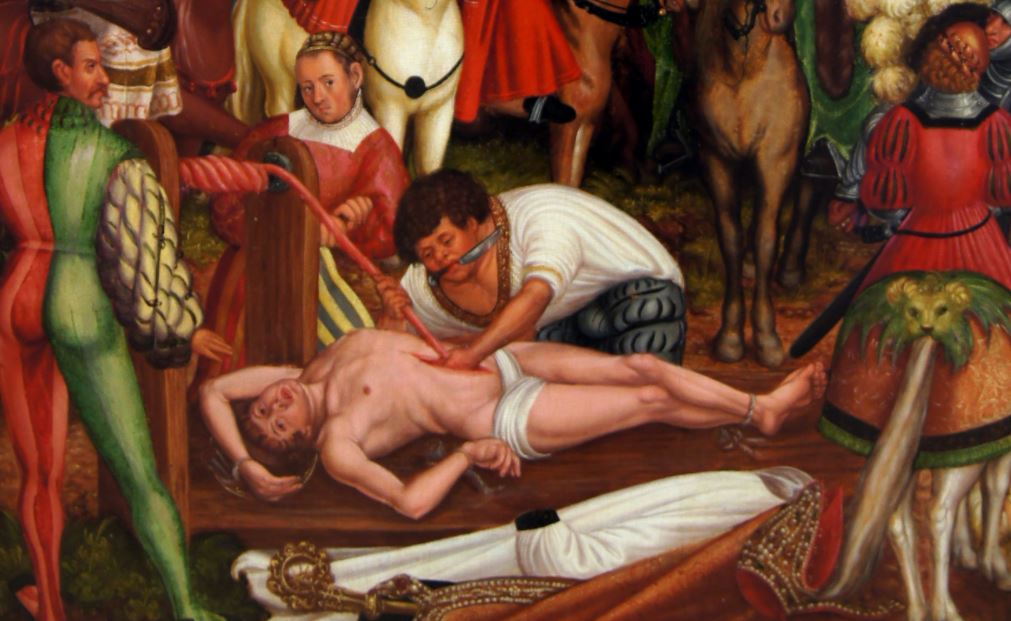
Many artists captured the loneliness of Christ on the cross, but the loneliness of Christ, even alone in the dark, is qualitatively different from that of the martyr saints. In their last moments, the saints are usually closely surrounded by their enemies, who are of course also their fellow, imperfect human beings. The pain of Christ, too, tends, for the most part, to be a remote and rarefied thing; it’s familiar to everyone, in an almost neutralised way, from living the cultural landscape of western society. But the pain of the saints is something we recognise in a more direct way. It’s unlikely, I hope, that many people reading this, have first-hand experience of fatal stonings, mutilations, disembowelings or bludgeonings, but these saints, with their looks of glazed shock and their vividly painted blood, are a figures we have become used to in other, secular contexts.
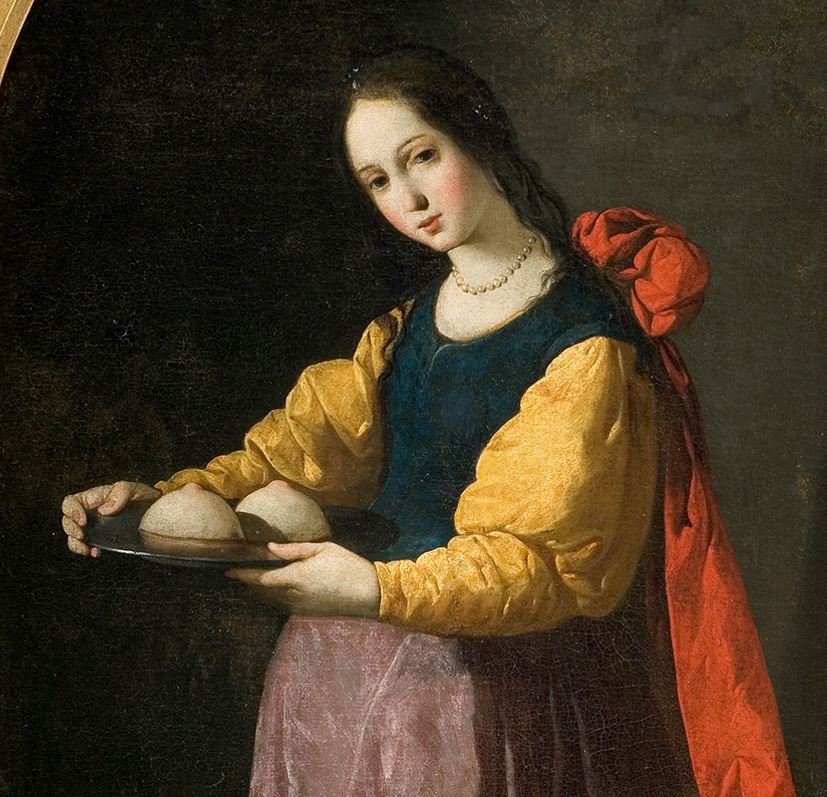
It’s fair to assume that these saints wanted to be remembered. But would they – and there are many, many more of them in addition to the few I’ve shown; from the big names like St Matthew and St John the Baptist (beheaded), to St Peter and St Andrew (crucified) to the more obscure, like Saints Cosmas and Damian (beheaded by pagans) and St Ursula (shot with an arrow by the Huns) to the theatrically horrific, like St Bartholomew (flayed and beheaded) and St Erasmus (intestines pulled out with a spindle) – have wanted to be remembered for the nature of their deaths? Even divorced from these kind of narrative paintings, the saints were rarely depicted without their sometimes bizarre attributes, the strangest ones that spring to mind being the aforementioned Agatha, in a more serene setting, bearing her severed breasts on a plate, or Saint Peter of Verona, normally depicted with the cleaver still embedded in his skull.
After the Age of Enlightenment, these explicit, visceral images more or less disappeared from western art for a couple of centuries, despite the occasional politically-motivated flashback like Jaques-Louis David’s Death of Marat (1793). Unexpectedly, they returned in a slightly altered and ideologically almost opposite, and certainly far more secular form in interwar Germany, made vivid by the horrors of World War One. But although a comparison with the Lustmord (sex murder) paintings of the Weimar Republic seems like, and possibly is, a flippant and/or blasphemous one, it feels valid, especially in relation to the paintings of St Agatha with their uncomfortably conflicting motives and coolly horrific imagery.
Paintings like George Grosz’s John the Sex Murderer (1918) and Otto Dix’s horrific Lustmord (especially the lost 1922 painting that exists only in black and white photos) have parallels with St Agatha, the painting I want to briefly talk about is less blatantly sensationalist and to my eyes at least has something of the heartbreaking empathy of Wolfgang Beurer’s St Stephen. Like Dix’s but less confrontational, Lustmord (1930) by the great Neue Sachlichkeit painter and photographer Karl Hubbuch, shows only the aftermath of the murder, rather than the act itself. But rather than losing force because of its relative restraint, Hubbuch’s image is imbued with all of the loneliness, fear, isolation and fragility seen in the face of Elseheimer’s St Stephen and the pitiful battered corpse of Beurer’s.
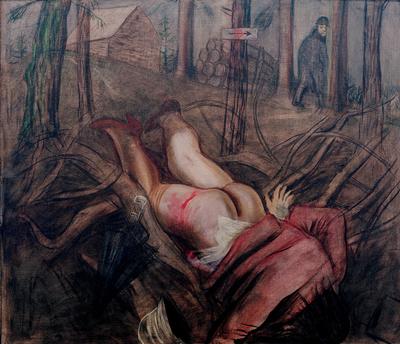
In the end, whatever the means or motivation for these pictures, what we are left with is the pictures themselves; and if they should survive beyond their meanings and attributions, people will, perhaps sadly, always be able to see what they represent. This is the opposite of art for art’s sake; but then, to appreciate the form of – for example – Wilfred Owen’s war poetry and study that form and its mechanics without taking into account what that apparatus is for is to miss the point. Likewise, the skill of a painter like Beurer, whose intention was to make the holy real and relatable, or of Elseheimer, or Sebastiano del Piombo, or even Karl Hubbuch, wasn’t there solely in an effort to amaze the viewer with the painter’s skill or advertise their technical ability.
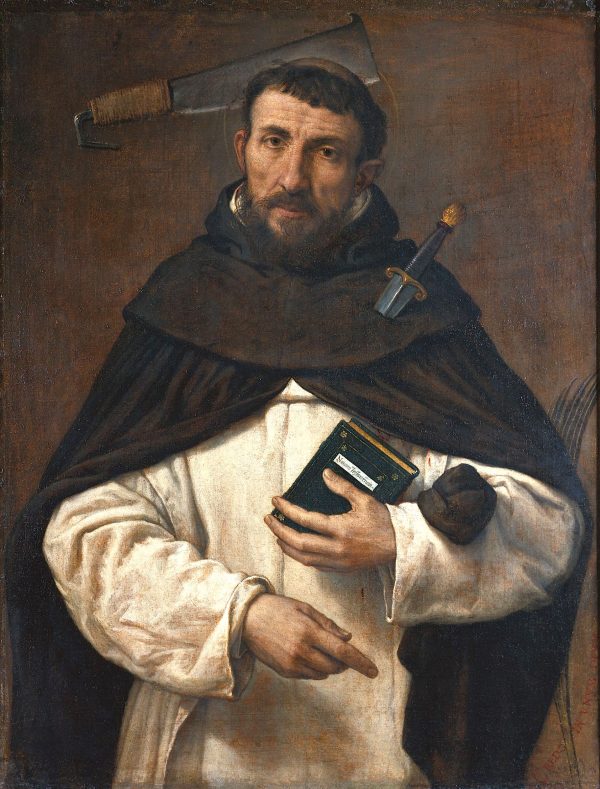
It may be that these sex workers and saints would have preferred, like Purcell and Tate’s Dido of Carthage, to be remembered, but to have their fates forgotten – but instead forget that you know the titles and subjects of these pictures. These people were, as many people still are, tortured, killed and disposed of without sympathy or ceremony. It would be nice if they were all remembered.

